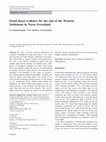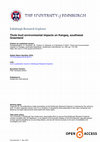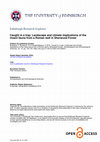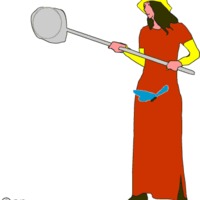Papers by Eva Panagiotakopulu

Naturwissenschaften, 2007
The fate of Norse farming settlements in southwest Greenland has often been seen as one of the gr... more The fate of Norse farming settlements in southwest Greenland has often been seen as one of the great mysteries of North Atlantic colonization and expansion. Preservation of organic remains in the permafrost of the area of the Western Settlement, inland from the modern capital Nuuk, allowed very detailed study of the phases of occupation. Samples were taken from house floors and middens during the process of archaeological excavations and from insect remains were abstracted and identified in the laboratory. In this study, we present a new paleoecological approach principally examining the fossil fly faunas from house floors. The results of our study provide contrasting detailed pictures of the demise of two neighboring farms, Gården under Sandet and Nipaatsoq, one where abandonment appears as part of a normal process of site selection and desertion, and the other where the end was more traumatic. The level of detail, which was obtained by analysis of the dipterous (true fly) remains, exceeds all previous work and provides insights otherwise unobtainable.

Journal of Archaeological Science: Reports, 2022
The wooden assemblage recovered from Hoyo de los Herreros cave (Reocín, Cantabria, Spain) in nort... more The wooden assemblage recovered from Hoyo de los Herreros cave (Reocín, Cantabria, Spain) in northern Iberia has provided an exceptional opportunity to enlarge our knowledge about perishable material culture from a unique medieval context. This case study enhances the information related to ephemeral material culture associated with the occupation of caves during the Middle Ages in northern Iberia, and the role played by wooden crafts in relation to activities performed within these dark and subterrain areas. All the wooden objects have been systematically studied and dated, combining wood analysis and morpho-technological study with the examination of entomological remains recovered from one of the objects which was in an advanced state of decay. The three bowls and a pointed twig recovered inside the cave were probably related to two different episodes of use, the first dated between 9th to 11th centuries CE, and the second between 11th and 12th centuries CE. It was possible to identify different stages of their chaîne-opératoires and the analysis of different aspects of their lifecycle, in tandem with the study of medieval wood crafting, specifically lathe-turning.
The limits of the glacier that occupied the southwest part of the southern Vale of York at the La... more The limits of the glacier that occupied the southwest part of the southern Vale of York at the Last Glacial Maximum are defined in relation to recent temporary exposures at Lindholme and previous regional mapping by Geoff Gaunt. Erratic content of associated diamicts indicates sources in the Yorkshire Dales, over Stainmore and along the Permo-Triassic outcrops on the west side of the Vale of York. The advance is dated to an episode associated with a high level of pro-glacial Lake Humber within the Last Glacial Maximum. Lidar imagery suggests that the northeastern ice limit is concealed beneath later alluvium of the rivers Ouse and Trent.

Quaternary International, 2018
Palaeoecological investigations of a rapidly eroding coastal midden and an adjacent peat bog on t... more Palaeoecological investigations of a rapidly eroding coastal midden and an adjacent peat bog on the island of Kangeq in southwest Greenland have provided new information on environmental change and human impact associated with Thule Inuit occupation. Palynological and palaeoentomological datasets have been produced through the 14 th to the 17 th centuries AD. The pollen and sedimentary data provide evidence for peat formation, increased frequency of the northern annual herb Koenigia islandica (Iceland purslane) from the end of the 15 th century AD, and a decline in shrub pollen over the same period. These changes are interpreted as local responses to Little Ice Age cooling. No clear signal for human impact on the vegetation was revealed in the pollen record, and there was little macroscopic charcoal recovered from either of the sedimentary contexts that were examined; microscopic charcoal evident in the peat column is probably evidence for domestic fires. The insect remains suggest periodic patterns of disposal on the midden and provide information on natural environments in the vicinity. Fossil fly puparia (Diptera) are associated with decaying animal materials and perhaps indicate waste produced from the skinning of marine mammals and birds as opposed to butchering. The faunas contrast with results from the Saqqaq site of Qeqertasussuk and several Norse farms.
Antiquity, 1999
Bed bugs have been troubling humans for at least 3550 years, as shown by examples from Tell el-Am... more Bed bugs have been troubling humans for at least 3550 years, as shown by examples from Tell el-Amarna. Here we report on the bug's habits and history, as revealed by archaeology.

Archaeological and Anthropological Sciences, 2016
Forest in Nottinghamshire is often considered a well preserved ancient landscape, subsequently ha... more Forest in Nottinghamshire is often considered a well preserved ancient landscape, subsequently having survived by way of centuries of management as a hunting preserve. Archaeological evidence suggests otherwise, with an enclosed landscape beginning in the pre-Roman Iron Age and continuing through the Roman period. Due to the nature of the region's soils, however, there is little empirical, palaeoecological evidence on its environmental history prior to the medieval period. This paper presents an insect fauna from a Roman well in a small enclosure in north Nottinghamshire, on the edge of Sherwood Forest, and its interpretation in terms of contemporary land use. Wells and small pools act as large pitfall traps and may effectively sample aspects of the local and regional insect fauna. The Wild Goose Cottage fauna and its environmental implications are also compared with a number of archaeologically and geographically similar contexts.
The use of a wide range of narcotic drugs in antiquity has been widely documented, although archa... more The use of a wide range of narcotic drugs in antiquity has been widely documented, although archaeologists have sometimes been too credulous of apparently scientific data, and have failed to appreciate the post-excavation histories of artefacts, including mummies. This paper examines the discovery of tobacco in the mummy of Rameses II, provides an alternative model for its origin, as a 19th-century insecticide used in conservation, and throws doubt upon the evidence for both cannabis and cocaine in ancient Egypt.
Journal of Archaeological Science
Geografiska Annaler Series A Physical Geography
Footprints on the Edge of Thule: Landscapes of Norse-Indigenous Interaction : A Major New Researc... more Footprints on the Edge of Thule: Landscapes of Norse-Indigenous Interaction : A Major New Research Programme
Water History, 2012
Southwest Greenland was settled, largely from Iceland, at the end of the tenth century. Agricultu... more Southwest Greenland was settled, largely from Iceland, at the end of the tenth century. Agriculture, based upon secondary products from domestic animals, lasted until the fifteenth century when the last farms were finally abandoned. From the twelfth century, the inhabitants had their own bishop and cathedral at Garðar in the more southerly Eastern Settlement and this, with several other sites, shows evidence of agricultural innovation in the use of irrigation as well as manuring of hayfields. This paper attempts to place the Greenland irrigated fields in their Icelandic and North European context, suggesting that their origins lie in the reorganisation consequent upon the arrival of the first resident bishop from Scandinavia in 1126 and his ability to call upon labour beyond that available on the episcopal farm.
Dorete-her book
... changing, land bridges, current since the days of Charles Darwin, and most elegantly discusse... more ... changing, land bridges, current since the days of Charles Darwin, and most elegantly discussed by George Gaylord Simpson (1940 ... Atlantic, amongst whom Dorete Bloch, Jens Böcher, Per Enckell, Gísli Mar Gíslason, Guðmundur Ólafsson and Claus Andreasen deserve special ...











Uploads
Papers by Eva Panagiotakopulu
Handed in to the Ministry of Antiquities in Egypt for publication in ASAE.